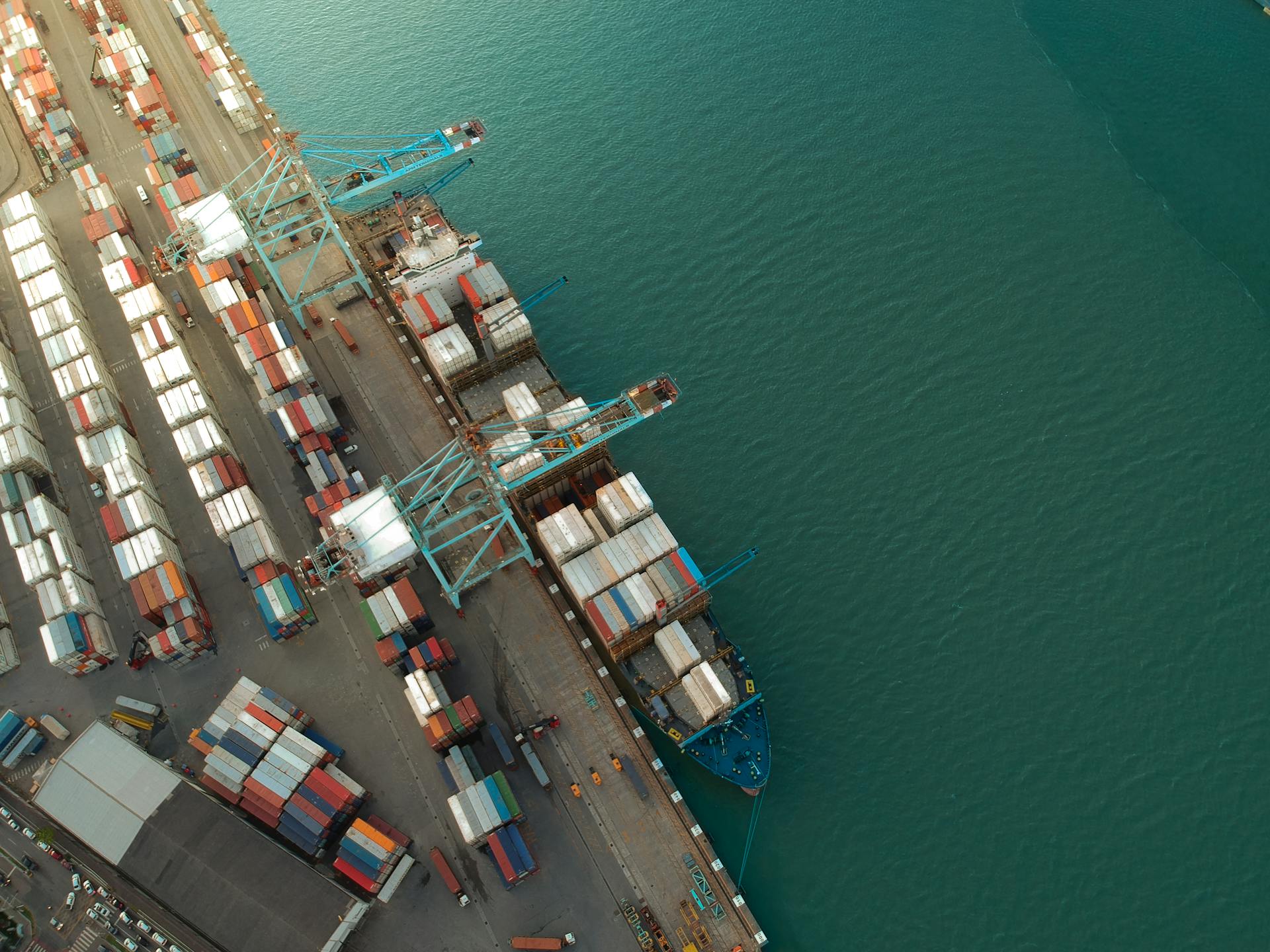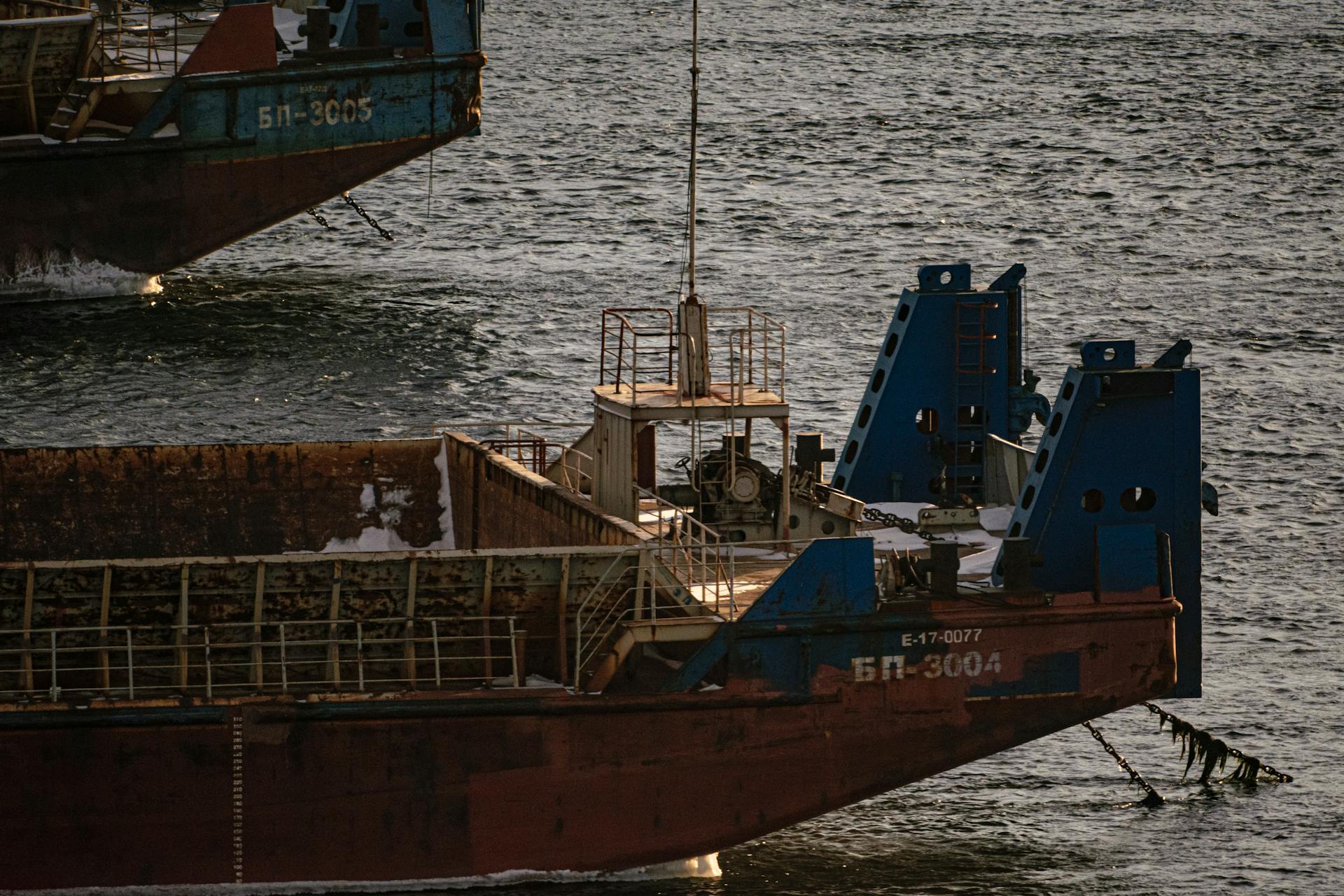
Canada has a vast coastline and numerous ports, making it an ideal destination for sea freight. The country's busiest ports include Vancouver, Montreal, and Halifax.
Canada's sea freight industry is heavily reliant on the St. Lawrence Seaway, a 3,700 km canal that connects the Great Lakes to the Atlantic Ocean. This waterway is a crucial transportation route for goods coming from Europe and Asia.
Canada's diverse geography and climate require specialized shipping containers to protect goods from extreme temperatures and weather conditions. Shipping companies must also comply with regulations set by the Canadian Food Inspection Agency to ensure the safe transportation of perishable goods.
Shipping to Canada can be complex, but with the right knowledge and planning, you can navigate the process with ease.
Planning Your Shipment
Planning Your Shipment can be a complex task, but understanding the basics can help you make informed decisions. The size of your shipment is a key factor in determining the best shipping method.

For smaller shipments, Canada Post Surface is a good option for packages weighing less than 20-30 kilograms. Economy air is a better choice for shipments between 30 and 100 kilograms.
As your shipment grows, so do your options. Shipments over 100 kilograms may be more cost-effective via economy air or less-than-container-load ocean, while packages over 500 kilograms are usually too costly for air freight and should be shipped via ocean.
Here's a quick reference guide to help you decide:
- Less than 20-30 kg: Canada Post Surface
- 30-100 kg: Economy air
- 100-500 kg: Economy air or LCL ocean
- Over 500 kg: Ocean
When to Ship?
Shipping to Canada by boat is worth it for companies with high-volume shipments, especially for goods like cars or computers. This method is less suitable for individual shipments, unless there are specific circumstances that justify the costs.
Economy Shipping or Global Shipping services can be a good option for companies, offering a competitive and economic rate with port-to-port transport, paperwork, and customs included. These services can help you save money on shipping costs.
For large shipments that don't fill a full container, Sea groupage (LCL) is a cost-effective option, especially for shipments of bulky personal effects. This method is also practical for small companies distributing goods.
Optimal Shipment Size
When shipping ocean, it's essential to choose the right size of shipment to save time and money.
If your shipment weighs less than 20-30 kilograms, Canada Post Surface is the way to go.
For shipments between 30 kilograms and 100 kilograms, economy air is a more cost-effective option.
However, if your shipment exceeds 100 kilograms, you may want to consider ocean freight or less than container load ocean as an alternative to air freight.
In fact, as a general guideline, any shipment that exceeds 500 kilograms in weight is too costly for air freight, making ocean a more viable option.
CargoMaster's sea freight services offer flexible options for larger shipments, including 20ft and 40ft containers to accommodate shipments of all sizes.
Here are some key dimensions for international shipping containers:
By considering these factors and choosing the right container size, you can ensure a smooth and efficient shipping process.
Consolidation of Orders
Consolidation of Orders can be a game-changer for shipping costs. By consolidating orders from different suppliers in Canada, you can save money on international shipping via sea freight. Our team is here to help you navigate the process.
If you have orders in Canada that need to be consolidated for international shipping via sea freight, consider contacting our team for a consultation. We can help you streamline your shipping process.
Shipping large or heavy items? As a general guideline, any shipment that exceeds 500 kg in weight is too costly for air freight. Over 100 kilograms chargeable weight is when shippers may consider looking at ocean as an alternative to air freight.
Here's a breakdown of shipment sizes and their corresponding shipping methods:
- Less than 20-30 kilograms: Canada Post Surface
- More than 30 kilograms but less than 100 kilograms: economy air
- Over 100 kilograms: Economy air or less than container load ocean
- Over 500 kilograms: Ocean
Cost and Pricing
Sea freight to Canada can be a cost-effective option, especially for large shipments. Sea freight shipping is one of the most economical ways to transport goods internationally.
The cost of a maritime shipment to Canada depends on various parameters, including the package's place of origin and destination, its weight and volume, type of transport, or the type of product or material being sent. Every package is unique, and it's essential to consult with a shipping expert to determine the package fees.
For very large packages, maritime transport is the most economic option, and filling a container through groupage can have a very economical result. The cost of a maritime shipment to Canada is the sum of the following parts.
Here's a breakdown of the common ocean freight shipping charges:
- Freight Rate: This is the cost of transporting goods from one port to another and is usually low in relation to other fees.
- Terminal Handling Charges (THC): Both import and export charges and typically assess on the container size.
- Documentation Fees: There are various documentation fees with ocean freight, such as the Bill of Lading (B/L) fee, documentation handling fee, and customs documentation.
- Customs Clearance Fees: Costs in relations to customs declarations and import fees.
- Fuel Surcharge: Typically apply as a percentage of the base freight rate.
- Container Freight Station (CFS) Charges: Services such as warehousing, container stuffing or de-stuffing, cargo consolidation, and handling.
- Storage Fee: Even a small delay can result in exorbitant storage fees.
- Security Charges: Security charges have become very common.
- Equipment Charges if special equipment is necessary.
The specific charges and amounts will vary depending on the shipping line, freight forwarder, and the terms of the contract or agreement.
Sea freight rates to Canada can vary depending on the weight and volume of the shipment. For example, at Atlantic International Express, the rates are as follows:
Note that a minimum weight of 1000 KG is required for booking, and the cut-off date for shipping is the 25th of every month.
Shipment Options
For smaller shipments, Less than 20-30 kilograms are best suited for Canada Post Surface, while more than 30 kilograms but less than 100 kilograms are better sent by economy air.
If your shipment exceeds 100 kilograms, you may want to consider ocean freight as an alternative to air freight. Over 500 kilograms is typically too costly for air freight.
Here are some general guidelines for choosing the right shipment option:
- Less than 20-30 kilograms: Canada Post Surface
- More than 30 kilograms but less than 100 kilograms: economy air
- Over 100 kilograms: Economy air or less than container load ocean
- Over 500 kilograms: Ocean
Typical Duration
Ocean freight transportation time can vary, but generally, allow for between 1 to 3 months.
A rough estimate for end-to-end shipping from Southwest Asia to Canada is usually within 2 months.
The "on the ocean time" is usually less than 20 days.
Most delays for ocean freight do not occur on the ocean.
Congestion at ports results in slower sailing speeds for ocean lines to minimize waiting time at the port.
LCL: Less Than Container Load

LCL, or Less than Container Load, is a shipping option that's perfect for smaller volumes of cargo. It's a cost-effective solution for those who don't have enough goods to fill an entire container.
LCL freight is a great option if you need to transport smaller volumes of cargo. This method of shipping consolidates multiple smaller shipments, offering cost advantages and other benefits.
Here's a general guideline to determine if LCL is right for you: any shipment that exceeds 500 kg in weight is too costly for air freight. Over 100 kilograms chargeable weight is when shippers may consider looking at ocean as an alternative to air freight.
LCL stands for Less than Container Load. Using this option, your goods will share a shipping container's capacity with others. This method of shipping is a great shipping option if you need to transport smaller volumes of cargo.
Some benefits of LCL shipping include cost advantages and the ability to consolidate multiple smaller shipments. This can be especially beneficial for businesses or individuals who have irregular or infrequent shipping needs.
A Partially Full Container Can Be Cheaper Than LCL
Shipping a full container load (FCL) might seem like a no-brainer, but it's not always the most cost-effective option. In fact, a partially full container can be cheaper than less-than-container load (LCL) shipping in some cases.
FCL freight doesn't always cost more, as LCL freight charges per cubic meter (CBM). This means that if you have a large item that takes up a lot of space, it might be more cost-effective to pay for an entire shipping container.
The cost of shipping a partially full container can be significantly lower than LCL, especially if you have a large or bulky item. For example, if you have a shipment that exceeds 500 kilograms in weight, it's likely too costly for air freight, and ocean freight might be a more affordable option.
Here's a rough guide to help you decide between FCL and LCL:
Keep in mind that the specific costs and shipping options will depend on your location and the type of goods you're shipping. It's always a good idea to get quotes from multiple shipping providers to compare rates and find the best option for your needs.
Choosing a Forwarder
Choosing a Forwarder is a crucial step in ocean shipping. Virtually all shippers access ocean vessels and shipping via a freight forwarder.
To find the right forwarder, you'll need to research their experience and expertise. They should have knowledge of the shipping industry and be able to navigate complex logistics.
A good forwarder will have a strong network of contacts and relationships with shipping lines. They can help you find the best routes and schedules for your cargo.
Their reliability and trustworthiness are also essential. You want a forwarder who will handle your shipment with care and keep you informed every step of the way.
By choosing a reputable forwarder, you can ensure a smooth and efficient shipping process.
Ecological and Environmental Considerations
Shipping goods to Canada via sea freight is a more ecological option than air freight. Ocean freight generates significantly less CO2 emissions, making it a more environmentally friendly choice.
CO2 freight emissions from ocean freight are a fraction of equivalent air freight. In fact, transporting 2 tonnes 5,000 kilometres via ocean results in less than 200 kg of CO2 emissions.
The same shipment via air generates over 6,000 kg of CO2 emissions, which is a staggering difference. This highlights the importance of considering the environmental impact of your shipping choices.
Considerations and Precautions
Transit times for ocean shipping to Canada can be slow due to slow port handling, customs, and other ocean processes. This can result in significantly longer transit times compared to air freight.
Tracking technology in ocean shipping can be lacking, making it harder to keep tabs on your shipment. This can be frustrating, especially if you're waiting for a critical delivery.
Be aware of surcharges and storage fees, which can add up quickly if there's a delay. Even a small delay can result in expensive storage fees, so it's essential to plan ahead.
Consider the Downsides
When shipping goods by ocean, there are some downsides to consider. Slow port handling, customs, and all ocean processes are slower than air freight.
Transit times can be a major issue, especially for de-consolidation of less than container loads. This can result in significantly longer transit times.
Tracking technology in ocean freight can be lacking compared to air freight. This makes it harder to stay on top of your shipment's progress.

Ocean freight is more prone to damage due to the much longer transit time. This can lead to costly repairs or replacement of damaged goods.
Shippers often report a myriad of surcharges, which can add up quickly. Even a small delay can result in expensive storage fees.
Here are some common ocean freight charges and surcharges to watch out for:
- Demurrage fees for delayed pickup
- Detention fees for delayed delivery
- Storage fees for goods held at the port
- Peak season surcharges for high-demand shipping periods
Canadian Amazon Removal Orders and Returns
Canadian Amazon Removal Orders and Returns can be a challenge, but there are solutions available. Minimum volumes are necessary to receive Amazon removal orders and other returns for forwarding via ocean freight.
Jet has solutions for this, and you can read more about managing cross-border Canadian Amazon removal orders on their website.
Ports and Routes
Canada has several major ports, each playing a significant role in the country's international trade. The most commonly used ports for sea freight to Canada are Halifax (Nova Scotia) and Montreal (Quebec).
Cargo from Europe traditionally transits from Rotterdam (Netherlands), Hamburg (Germany), and Antwerp (Belgium) to these ports. Cargo from Southern Europe commonly transport from Barcelona (Spain), Genoa (Italy), or Marseille (France) to Canada as well.
The transit times vary but average between 20 to 25 days, with door-to-door transit times ranging from 1 to 2 months.
Port of Halifax:
The Port of Halifax is a significant hub for sea freight shipping in eastern Canada. Located on the eastern coast of Nova Scotia, Canada, this deep-water port has direct rail connections, making it an ideal choice for companies looking to ship their goods internationally.
Canada has a long coastline and several islands, making sea freight a convenient option for delivering goods. In fact, Canada hosts more than 550 seaports, ensuring that you can ship your goods from the U.S. to Canada via sea freight.
The Port of Halifax provides access to eastern Canada and the USA, making it a strategic location for businesses looking to export or import goods.
Common Routes
Canada has several major ocean ports, each with its own unique specialties and capacities. The Port of Vancouver is the largest port in Canada and serves as the major gateway for trade with Asia-Pacific countries.
Ocean shipping routes to Canada vary depending on the origin of the cargo. From Europe, cargo commonly transits from Rotterdam, Hamburg, and Antwerp to Halifax or Montreal. Some cargo even ships first to the Port of New York/New Jersey and then transits in bond to Canada.
The transit times for ocean shipping to Canada can vary, but they generally average between 20 to 25 days. However, door-to-door transit times can take up to 2 months.
Here are some common ocean shipping routes to Canada:
- Europe: Rotterdam, Hamburg, Antwerp to Halifax or Montreal
- Southern Europe: Barcelona, Genoa, Marseille to Canada
- Northern Europe: Rotterdam, Hamburg, Bremerhaven to Vancouver
- Asia: Straight across the Pacific to Vancouver, or through the Strait of Georgia
- India: Door-to-door transit time is approximately 40 days
These routes and transit times are just a starting point, and the actual shipping schedule will depend on various factors, including weather conditions and shipping schedules.
South America & Caribbean
The South America and Caribbean region is a major hub for ocean shipping routes. Cargo from South America often transits via the port of Miami for southbound cargo.
Transit times between South America and Canada typically average around 30 days. This can vary depending on the ports of departure and arrival, as well as the type of cargo.
Cargo from South America commonly travels to Canada, as well as to other ports such as Santos, Rio de Janeiro, Buenos Aires, Valparaíso, and Callao.
Shipping Containers
Shipping containers come in various sizes, with 20ft and 40ft being the most common. These containers are ideal for larger shipments, and can be used for commercial goods, household items, or industrial machinery.
The dimensions of shipping containers vary, but a 20ft standard container measures 5.92×2.34×2.38 meters, with a door opening of 2.29×2.28 meters. In contrast, a 40ft standard container measures 12.06×2.35×2.38 meters, with a door opening of 2.29×2.28 meters.
If you have enough cargo to fill a container, shipping a full container (FCL sea freight) is always preferable. This can save you time and money in the long run, as it eliminates the need for additional processing days and reduces the cost of additional warehousing, unloading, and sorting.
FCL Full Container Load
FCL Full Container Load is a shipping option that's perfect for businesses with large quantities of goods to transport. It's a great way to ensure your cargo arrives safely and efficiently.
FCL stands for Full Container Load, and it means you have enough cargo to fill an entire shipping container. This can be a 20-foot or 40-foot container, depending on your needs.
Shipping a full container is always preferable whenever possible, as it's often the most cost-effective option. It's also a good idea to fill the container as much as possible, as this can help reduce costs.
One of the key benefits of FCL shipping is that it's faster than LCL shipping. Since you're not sharing a container with other shipments, your cargo will arrive more quickly.
FCL shipping is also a popular choice for businesses that need to transport large quantities of goods to specific destinations. Our experts collaborate with our partners to ensure you receive the best in class shipping service.
Here are some key benefits of FCL shipping:
- Faster shipping times
- More cost-effective option
- Perfect for large quantities of goods
Container Sizes
Container sizes vary depending on the type and purpose of the shipment.
A 20ft container is a common size for smaller shipments, measuring 5.92×2.34×2.38 meters inside and having a door opening of 2.29×2.28 meters.
For larger shipments, a 40ft container is often used, measuring 12.06×2.35×2.38 meters inside and having a door opening of 2.29×2.28 meters.
You can choose from various types of containers, including standard, open top, reefer, and flatrack.
Here is a list of container sizes and their corresponding dimensions:
Self-Pack Containers
Self-Pack Containers offer a flexible solution for personal relocations and small businesses shipping to Canada.
You can pack your own goods at your own pace, which is a big advantage for those who value control over their shipments.
CargoMaster delivers empty 20ft or 40ft containers directly to your location, giving you the space to organize and load your items with care.
Their team provides guidance on efficient packing techniques to maximize space and protect your goods during transit.
Weekly departures to Canada ensure prompt and reliable delivery to key cities and regions.
Whether you're moving household items, furniture, or business equipment, Self-Pack Containers offer a combination of convenience, affordability, and security.
Customs and Documentation
Navigating customs regulations can be complex, but CargoMaster takes the stress out of the process with expert customs clearance services.
Their experienced team prepares accurate documentation and ensures compliance with Canadian import regulations, streamlining the process to minimize delays and complications.
Calculating duties and taxes, managing pre-shipment inspections, and facilitating smooth coordination with customs officials are all part of their comprehensive customs clearance services.
With decades of experience, CargoMaster delivers reliable, efficient, and transparent customs solutions, giving you peace of mind throughout the journey.
Customs Clearance
Navigating customs regulations can be a complex and stressful process, but CargoMaster takes the stress out of customs clearance with expert services.
Our experienced team manages every detail of the process, from preparing accurate documentation to ensuring compliance with Canadian import regulations. This includes calculating duties and taxes, managing pre-shipment inspections, and facilitating smooth coordination with customs officials.
CargoMaster's meticulous approach ensures that every aspect of your shipment complies with Canadian regulations, giving you peace of mind throughout the journey. We understand the nuances of international logistics and take pride in delivering reliable, efficient, and transparent customs solutions.
With decades of experience, CargoMaster is the trusted partner you need for seamless shipping to Canada.
Overview of Bills of Lading: Precision
A Bill of Lading is meticulously crafted to capture every detail of your shipment, providing an exact representation of your cargo. This document is crucial for identifying your shipment and resolving disputes, especially in cases of damaged, lost, or delayed shipments.
The date on the Bill of Lading is significant, as it marks the enforcement of the shipment contract. Maritime regulations emphasize the importance of accuracy in shipping dates, marks, and cargo descriptions.
Freight Forwarders like CargoMaster play a vital role in compiling the Bill of Lading, ensuring accurate details such as container and bolt seal numbers, vessel information, weights, pieces loaded, and voyage numbers. This attention to detail helps prevent errors and disputes.
The Bill of Lading is a contract between the International Shipping Company and the cargo shipper, mirroring other contractual agreements. To meet international standards, Bills of Lading must align with conventions such as The Hague Rule, Hague-Visby Rule, Hamburg Rule, and The Carriage of Goods by Sea Act Australia 1991.
CargoMaster, handling machinery and out-of-gauge cargo, faces additional documentation requirements for compliance with international regulations. This highlights the importance of careful documentation in international shipping.
Export Documents from India
When shipping goods from India to Canada, you'll need to prepare the necessary export documents. The consignee's passport copy is a required document, including arrival and departure stamps.
The consignee's visa copy is also essential for sea freight shipping. This document helps ensure the consignee has the necessary permission to receive the goods.
You'll also need an encashment certificate to complete the export documents. This certificate verifies the payment for the goods being shipped.
Here's a list of the mandatory documents required for sea freight shipping from India to Canada:
- Consignee Passport Copy: Including arrival and departure stamps.
- Consignee Visa Copy
- Consignee Ticket Copy
- Encashment Certificate
Sources
- https://www.purolatorinternational.com/when-to-use-air-sea-or-ground-when-shipping-from-the-u-s-to-canada/
- https://www.jetworldwide.com/blog/understanding-canadian-ocean-freight-options
- https://www.cargomaster.com.au/international-freight/north-america-freight-shipping/canada/
- https://laluna.coop/en/sea-freight-to-canada-cargo/
- https://atlanticcourier.net/india-to-canada-sea-freight
Featured Images: pexels.com


